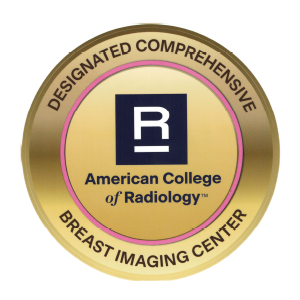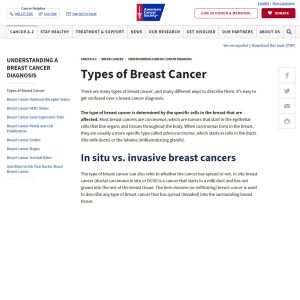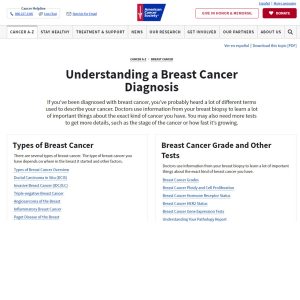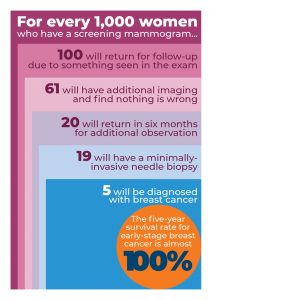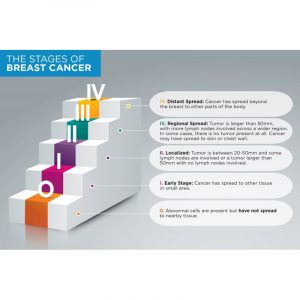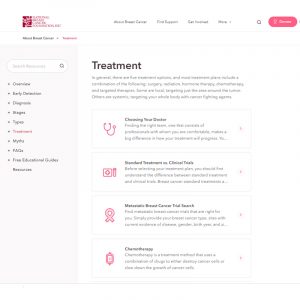The Basics of Breast Cancer
Breast cancer is, simply put, a type of cancer that starts in the breast. Breast cancer cells usually form a tumor that can often be seen on an x-ray (mammogram) or felt as a lump in the breast. Breast cancer occurs almost entirely in women, but men can get breast cancer as well.
It is important to understand that most breast lumps are benign (not cancerous). They are not life threatening, though some types of benign breast lumps can increase a woman’s risk of getting breast cancer. Any breast lump or change should be checked by a physician to determine if it is benign or malignant (cancerous), and whether or not it will affect your future cancer risk.
Types of Breast Cancer
There are many different types of breast cancer. Common types include ductal carcinoma in situ (DCIS) and invasive carcinoma. Others, like phyllodes tumors and angiosarcoma are less common. The American Cancer Society provides a comprehensive overview of types of breast cancer.
A breast cancer diagnosis often involves a biopsy, in which a small sample of tumor tissue is tested for specific proteins that indicate the presence of cancer. The tumor cells are also closely looked at in the lab to determine the tumor “grade.” The specific proteins found and the tumor grade can help physicians and patients decide among treatment options.
To learn more about specific types of breast cancer and tests done on the breast cancer cells, read “Understanding a Breast Cancer Diagnosis” from the American Cancer Society.
Estimating Your Breast Cancer Risk
The National Cancer Institute offers an online risk assessment tool based on a statistical model. The tool uses a woman’s own personal information to estimate risk of developing invasive breast cancer over specific periods. Access this tool at bcrisktool.cancer.gov/calculator.html
This assessment is not meant to be a substitute for consultation with a medical professional. Advanced Radiology supports the guidelines of the American College of Obstetrics and Gynecology and the American College of Radiology that recommend women have a mammogram performed annually beginning at age 40. All mammograms at Advanced Radiology are interpreted by subspecialized and fellowship-trained breast Radiologists.
Early Detection Saves Lives
According to the American Cancer Society, when breast cancer is detected early, and is in the localized stage, the five-year relative survival rate is 99%. Early detection includes performing monthly breast self-exams, and scheduling annual clinical breast exams and mammograms.
To request an appointment for your annual mammogram, click here.
The National Breast Cancer Foundation’s instructions for performing a breast self-exam can be found here.
Breast Cancer Stages
Once a person is determined to have a malignant tumor or the diagnosis of breast cancer, the healthcare team will determine breast cancer staging to communicate how far the disease has progressed.
After a breast cancer diagnosis, your doctor will try to determine if the cancer has spread, and if so, how far. This process is called staging. The stage of a cancer describes how much cancer is in the body, how serious the cancer is, and how best to treat it. Doctors also use a cancer’s stage when talking about survival statistics.
Treatment Options
There are five basic breast cancer treatment options, and most treatment plans include a combination of surgery, radiation, hormone therapy, chemotherapy, and targeted therapies. Some are local, targeting just the area nearest the tumor. Others are systemic, engaging your entire body with cancer fighting agents.
Your individual treatment begins with the selection of your treatment team. Finding the right team, one consisting of medical professionals whom you trust, makes a big difference in how your treatment will progress. Your physicians should certainly be knowledgeable, but they should also welcome your questions and be able to maintain your trust as guide and advisor.
Women’s Imaging at Advanced Radiology
Mammography and 3D Breast Tomosynthesis
Ultrasound-Guided Breast Biopsy
If you have any other questions, or need additional information, contact us here.
